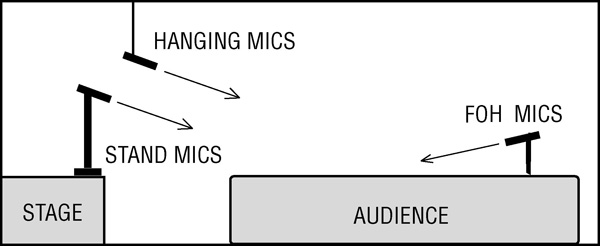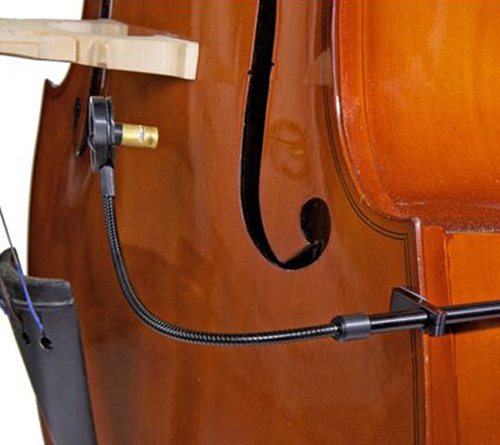
Drums (kick). Remove the front head or go inside the hole cut in the front head. Inside, on the bottom of the shell, place a pillow or blanket pressing against the beater head. This dampens the decay portion of the kick drum’s envelope and tightens the beat.
Place a cardioid dynamic with a presence peak and a deep low-frequency response inside a few inches from the beater. For extra attack or click, use a wooden beater and/or boost EQ around 3 kHz to 6 kHz. Cut a few dB around 400 Hz to remove the “papery” sound.
Drums (simple miking). For jazz or blues, sometimes great results can be had with one or two large-diaphragm condensers (or a stereo mic) overhead, and another mic in (or in front of) the kick. There may be need to add another mic near the snare drum.
As an alternative, clip a mini omni to the snare drum rim, in the center of the set, about 4 inches above the snare drum. With a little cut around 200 Hz or so, the sound can be surprisingly good. This can be enhanced with another mic in the kick.
Bongos and congas. Place a cardioid dynamic near each drum head.
Xylophone and marimba. Deploy two flat-response condensers 18 inches above the instrument and 2 feet apart.

Acoustic bass. There are several options. For the best isolation, use the player’s pickup if available. Plug it into a DI box. Or mike the player’s amp up close up (if one is being used). A mini mic just inside the instrument’s f-hole provides excellent isolation but tends to sound “hollow,” while taping a mini near the f-hole can work if excess bass is rolled off.
Another approach is a flat-response cardioid a few inches out front, even with the bridge. The Applied Microphone Technology AMT S25B clamps onto the bass body and mounts a directional mic on a gooseneck (Figure 3). One more: wrap a cardioid dynamic in foam and stuff it in the tailpiece aiming up. Cut EQ around 700 Hz for tailpiece miking.
Banjo. Tape a mini omni to the drum head about 2 inches in from the rim, or on the bridge. Or, place a flat-response condenser or dynamic 6 inches from the drum head, either centered or near the edge.
